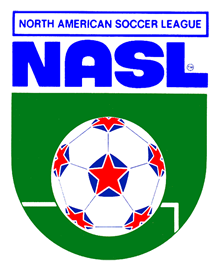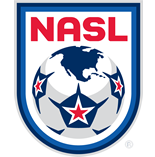NASL 1968-1984

The original NASL lasted from 1968 to 1984. In that period of time, high level soccer was brought to North America by world class superstar players including Pele, Johan Cruyff, Franz Beckenbauer, George Best, Gordon Banks, Geoff Hurst, Eusiebo, Giorgio Chinaglia, Teofilo (Nene) Cubillas and Bobby Moore, among others.
World Soccer Columnist, Brian Glanville who has written about the game for over fifty years listed five former NASL players (Pele, Banks, Cruyff, Beckenbauer and Moore) in his all time world best XI.
Phil Woosnam played a leading role in the development of the sport in the United States beginning in the 1960s. After a successful playing career in England, the Welshman emigrated the United States in 1966, and became coach of the Atlanta Chiefs in 1968, winning the inaugural NASL Coach of the Year honor.
That year, Woosnam became the Head Coach of the US Men's National Team as well as the Commissioner of the NASL. He remained the commissioner of the NASL until 1982. During his tenure, Woosnam oversaw unprecedented growth in the game including the signing of several top international stars, expansion to several new markets that had never experienced professional soccer previously, and the securing of the first national network television contract for soccer.
Woosnam is an inductee in the National Soccer Hall of Fame and sadly passed away in July 2013, aged 80.
Letter from Phil Woosnam to the NASL when the NASL was making plans to return in its present form.
“It is a great honor to welcome all of you, owners and club executives of the new NASL, to this meeting. What an exciting time for soccer in this country. To think that you are here to renew and continue the legacy of the NASL, and to connect past with present, is indeed a wish fulfilled for me.
It was a long road, but a short time, from our office in the basement of the Atlanta Braves Stadium in 1969 with five teams, to our New York accommodations where the NASL ultimately became twenty-four teams in 1978. My hope for all of you is to repeat and, in the near future, surpass that success.
It was not all easy but definitely worthwhile. Our challenge was to find players, coaches, management and yes, fans who would understand and appreciate our great game. You now have a National Team that will be playing England in round one of the World Cup and, has the skill to win! I'm proud of the many foreign players who helped build our league and even prouder of the many North Americans who learned their skills by playing alongside those talented players. They have passed those skills down the line. You will have a great talent pool and perhaps still, as Europe is now doing, import a limited number of fine players from other countries, on a loan basis. That combination will bring fans to your stadiums just as it did for the first NASL.
Good luck with your meeting and plans for the future. With very best wishes, Phil”
The history of the North American Soccer League
The original North American Soccer League (NASL) was a professional soccer league with teams in the United States and Canada that operated from 1968 to 1984. The league final was called the Soccer Bowl from 1975 to 1983 and the Soccer Bowl Series in its final year, 1984.
The league’s popularity peaked in the late 1970s. The league averaged more than 13,000 fans per game in each season from 1977 to 1983, and the league’s matches were broadcast on network television from 1975 to 1980. The league’s most prominent team was the New York Cosmos. During the mid-to-late 1970s, the Cosmos signed a number of the world’s best players, including Pelé, Franz Beckenbauer and Carlos Alberto, and the Cosmos averaged over 28,000 fans for each season from 1977 to 1982 while having three seasons of the average attendance topping 40,000 spectators per game. The league additionally played indoor soccer from 1975–1976 and 1979–1984.
In 1967, two professional soccer leagues started in the United States: the FIFA-sanctioned United Soccer Association, which consisted of entire European and South American teams brought to the U.S. and given local names, and the unsanctioned National Professional Soccer League. The timing of the creation of these professional leagues was related to the huge amount of attention given throughout the English-speaking world to the victory by England in the 1966 FIFA World Cup.
The two leagues merged in December 1967 to form the North American Soccer League, which began the 1968 season with 17 of the 22 teams that has participated during the 1967 season. The teams relied mostly on foreign talent, including the Brazilian Vavá one of the leading scorers of the 1958 and 1962 World Cups. International friendlies included victories against Pele’s Santos and against English champions Manchester City.
The NASL felt it needed to sell the sport of soccer to North Americans, which was then completely foreign to the majority of them. The league modified the rules in the attempt to make the game more exciting, and comprehensible, to the average sports fan. These changes included a clock that counted time down to zero as was typical of other timed American sports, rather than upwards to 90 minutes as was traditional. NASL implemented in 1972 a 35-yard line for offside (a rule change designed to reduce prevalent offside traps) rather than the usual half way line, but in 1982 FIFA put an end to this NASL rule change. The NASL introduced a penalty shootout in 1974 to decide matches that ended in a draw. The league also carried over the points system used by the NPSL the previous year in which teams were award 6 points for win, 3 for a draw, plus up to 3 bonus points for each goal scored. Indeed, on five occasions this nontraditional system gave the premiership to a team other than the one with the best record.
In 1971, NASL added three teams in the New York Cosmos, Montreal Olympique, and the Toronto Metros.
On September 3, 1973, Sports Illustrated featured a soccer player on its cover for the first time - Philadelphia Atoms goalkeeper Bob Rigby. SI profiled the Philadelphia Atoms victory in the NASL championship, the first time an American expansion sports team won a title in its first season. Philadelphia averaged 11,500 fans in 1973, the first time since 1967 that any North American professional soccer team had averaged more than 10,000 fans. The cover title declared ‘Soccer Goes American’, as Philadelphia had started six Americans in the championship match.
NASL’s average attendance had grown steadily from a low of 2,930 in 1969 to 7,770 in 1974, and by 1974 four teams were averaging over 10,000 attendance. The 1974 NASL Championship game between the Los Angeles Aztecs and the Miami Toros was televised live on CBS, the first national broadcast of a pro soccer match in the United States since 1968.
The 1974 and 1975 seasons saw rapid expansion for NASL. West coast expansion was a success, with three of the teams — San Jose, Seattle and Vancouver — averaging more than 10,000 fans in 1974. In 1975, five more franchises were added, meaning the NASL had grown from 9 teams in 1973 to 20 teams by 1975.
Pelé’s arrival at the New York Cosmos created a media sensation and overnight transformed the fortunes of soccer in the United States. From the moment he signed his contract at the 21 Club on June 10, 1975 in front of a crush of ecstatic worldwide media, Pele’s every move was followed, bringing attention and credibility to soccer in America. The New York Cosmos’ home attendance tripled in just half the season Pele was there, and on the road the Cosmos also played in front of huge crowds that came to watch Pelé play.
Pele’s arrival resulted in greater TV exposure for the Cosmos and for the league overall. Ten million people tuned in to watch CBS’ live broadcast of Pele’s debut match—a record American TV audience for soccer—with the Cosmos on June 15, 1975 against the Dallas Tornado at Downing Stadium in New York.
The NASL brought in six new teams, raising the league’s teams from 18 to 24 for the 1978 season. As of 1979, NASL rules required that each squad start two U.S. or Canadian players and that each 17-man roster carry six native players. In 1980, the minimum number of U.S. and Canadian starters was raised to three.
With the NASL declining rapidly in the early 1980s and losing many franchises, NASL made several changes in an attempt to keep the league going, but on March 28, 1985, the NASL suspended operations for the 1985 season.
The original NASL introduced soccer to the North American sports scene on a large scale for the first time, and was a major contributing factor in soccer becoming one of the most popular sports among American youth. On July 4, 1988, FIFA awarded the hosting of the 1994 World Cup to the United States.


